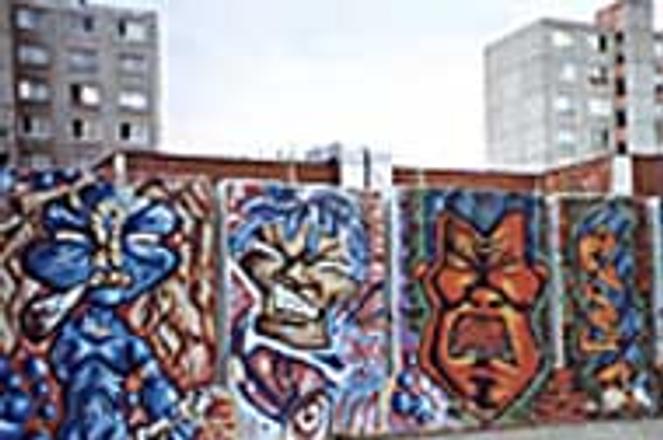Slovak graffiti practitioner Marian Šoltýs poses with his five masterpieces in the Bratislava suburb of Dúbravka. Unlike in the Czech Republic, where police are cracking down on taggers, Slovakia's artists are losing steam.photo: Matthew J. Reynolds
Graffiti has long been a means of advertising human needs, at times both a trade and an art form, always a vehicle for self-expression. Indeed, modern-day bathroom stalls and grade-school desks testify to the fact that at least some aspects of human nature haven't much changed over the years.
The urge to fill empty spaces goes a long way in explaining how many modern graffiti artists get started, but does nothing to express the depth of their devotion. Bratislava's Marian Šoltýs, a 22 year-old auto mechanic, says the combination of adrenaline and artistic expression which is graffiti becomes an addiction. "Graffiti is a drug," he asserts. "Absolutely a drug. Once you start, you can't stop."
Šoltýs first became hooked in 1993. A prolific doodler, he started listening to rap music in the late 80's and early 90's and became enamoured with the artwork he saw, much of it graffiti, in music videos. From there, he bought a can of paint and started spraying his tag, or signature, throughout his neighbourhood, developing his own style and gradually tackling more elaborate projects.
"I was part of Bratislava's first crew, called CBC, the colour brothers crew," he recounted on a recent afternoon as he thumbed through a mountain of old photographs he keeps in his room in Dúbravka. One of the photos he picked out depicted a bright yellow mural with an enormous black head smoking a cigarette, a work he helped create underneath La Franconi bridge in 93' (it has since been painted over). "That was the first piece of real graffiti ever in Bratislava," claims Šoltýs. "It was done by three of us. My tag was Slimer, and the other two were Hum and Spok."
Although Šoltýs doesn't go out much anymore, every bit of his squat, energetic frame and wild, lupine eyes lights up when he talks about graffiti. In his heyday he sprayed three times a month, mostly around his native Dúbravka and under Lafranconi, but also in Zlaté Piesky and in Petržalka, where he was once paid by a pub owner for his work.
His masterpieces (see photo) - five spunky, colourful paintings exploding off rectangular slabs of concrete - adorn concrete walls behind the large, grey block of flats in which Šoltýs lives. "It's never the same, but to do one probably took me about four hours each," he said of the works, which he completed in 1996.
Although not true of every graffiti artist, Šoltýs usually scribbles a rough sketch at home before going out with his cans. When he gets to the designated spot he copies the outline - the longest and most painstaking part of the process. When that's finished, colour is added, while detailed trimmings and touch-up work come last. When satisfied that everything is complete, he says he spends a few moments to savour his work, often takes a picture, and then sprints off hoping it won't be painted over too quickly.
Roots
The modern practice of graffiti began as a part of the developing early 70's hip-hop culture in New York City where it became fashionable to spray nicknames on public walls and subways. As competition for space and attention grew fierce, tags became larger and more involved. Eventually an underground artform emerged with innumerable styles and concepts.
The practice came to the former Czechoslovakia after communism fell in 1989, appearing first in Prague and then several years later in Bratislava. Around 1995 graffiti experienced a boom in the capital, but since then interest has levelled off. Bratislava does not have the sheer amount of graffiti as a city such as Prague, for example, nor has the scene developed much beyond tagging.
Šoltýs counts himself among the few Slovaks who actually took an active interest in learning about graffiti's history. In his room he has stacks of graffiti magazines and pictures from neighbouring countries. "I live in an area where people live in enormous, grey eyesores. People in my neighbourhood are happy when I spray something," he insists. "I'm not the greatest graffiti artist in the world, but I know that I have good ideas, and that what I do is art."
Unfortunately not all graffiti artists are as committed. The bulk of what the average person sees on a daily basis is incoherent chicken scratch. "I'd say about 90% of people who do graffiti in Bratislava are just into it as a fad," estimated Šoltýs. "And those who would draw on an old building or a church are just punks."
As is the case in most cities, efforts by Bratislava officials to confine graffiti to authorised areas have failed. "In 1996 there was an attempt to designate certain places for graffiti," said old town spokesman Milan Vajda. "The graffiti artists were not hostile to these attempts, but it seems that it's a spontaneous activity that loses its appeal when controlled."
In general, Bratislava police do not seriously crack down on graffiti artists. When a person is caught in the act, they are usually given a fine or a conditional sentence. Šoltýs said he once had to pay 200 Slovak crowns ($4.50), while at other times his paint has been taken away. But more often than not, he says, quick feet have rescued him from either outcome.
But it is not pressure from the police which has caused Šoltýs to all but hang up his cans. Rather, he says, it's the passage of time: "All the friends I used to go out with are now adults and they're no longer interested. It's not so fun going out alone, and I don't want to hang out with 15 year-olds."
"But I miss it," he added. "Damn, how I miss it."
Additional reporting by Zuzana Habšudová


